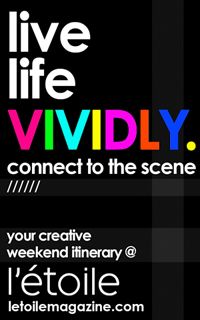Many a strange, wondrous, and totally off-the-wall production has occurred behind the dilapidated storefront-turned-rogue art space
 that is 1419. In fact, we might venture to say that nothing conjured there could ever surprise us – except that erased bobrauschenbergamerica, a new-fangled collective autobiography and multidisciplinary extravaganza opening Friday, just might prove us wrong. And trust us, that’s a compliment. Prolific amounts of fog, tires, and Barry White? Check. Original line dances, sing-alongs and video projections? Double check. Five questions with ringleader Ben Gansky (who’s actually much more sane than you’d think)? We got ya covered. Read what you’re getting into, muster a big “eff yeah America” (the show’s all about American identity, see) and get your tickets while they’re hot.
that is 1419. In fact, we might venture to say that nothing conjured there could ever surprise us – except that erased bobrauschenbergamerica, a new-fangled collective autobiography and multidisciplinary extravaganza opening Friday, just might prove us wrong. And trust us, that’s a compliment. Prolific amounts of fog, tires, and Barry White? Check. Original line dances, sing-alongs and video projections? Double check. Five questions with ringleader Ben Gansky (who’s actually much more sane than you’d think)? We got ya covered. Read what you’re getting into, muster a big “eff yeah America” (the show’s all about American identity, see) and get your tickets while they’re hot.l’etoile: Fireworks, bubbles, kazoos, and, if we heard correctly, a large chicken suit? What kind of theater performance is this?
Ben Gansky: Well, a very strange kind of theatre performance. One of the goals of this project was to mess around with conventions of theatre and of genre, to really have fun with the possibilities afforded by the live event of performance. I think that most theatre uses only a fraction of the spectrum of possibility of what can occur onstage in front of an audience. So we're using video projections, live and recorded original (and not original) music, audience address, and some performance-based technology in part to try to push the envelope of what can happen in a 'theatre performance'.
It's also a bit different from an ordinary 'theatre performance' in that most of the lines in the play have been rewritten by the people speaking them to reflect their own stories and experiences. So you've got people looking the audience right in the eye and telling stories from their own lives, intermingled with text from a variety of sources, from Foucault to Bob Dylan to Tom Stoppard to Whitman.

Who is this Robert Rauschenberg character? Or more specifically, what elements of his work are reflected in erased bobrauschenbergamerica?
Robert Rauschenberg was one of the more influential artists of the second half of the twentieth century. He pioneered the use of appropriation, collage, and juxtaposition in his art to create work that could not be reduced to representation. erased bobrauschenbergamerica is inspired by Rauschenberg's working methods and his focus on the idea of art, playing with his materials, and on 'America', whatever that might be. Rauschenberg also had a brief foray into performance art and choreography in the late 1960s--he also designed costumes and sets for, and went on tour with, Merce Cunningham's dance company. The set design by Brian Nigus is inspired by two different Rauschenberg fabric series, Jammers and Hoarfrost.
There are references throughout the piece to some Rauschenberg motifs--the chicken is a big one. There are some Rauschenberg quotes used in the performance. And throughout this process, I've tried to let my decisions as a director be guided by a few choice Rauschenberg quotations--for instance, he said, "I always have a good reason for taking something out [of a work]. I never have a good reason for putting something in." He worked from a playful, child-like place, and I've really enjoyed turning to that spirit again and again in making this piece.
The title of e-bra is inspired by one of Rauschenberg's earliest pieces to gain wide recognition, Erased de Kooning Drawing, which Rauschenberg made by asking the painter William de Kooning (who at the time was the painting world's big rockstar) for a piece which he (Rauschenberg) could erase. De Kooning gave him a drawing, Rauschenberg works for a month to erase it--it was mixed media, with charcoal, and pastel, and paint (de Kooning told him if he was going to give him a drawing, he was going to give him one that would be a challenge to erase). When Rauschenberg had stripped away all that he could of de Kooning's drawing, he exhibited it as "Erased de Kooning Drawing by Robert Rauschenberg." It sparked a lot of controversy.
I suppose if I had to pick an epigram for this entire performance, it might be: "Painting relates to both art and life. Neither can be made. I try to act in the gap between the two."

What was your adaptation/re-creation process like? How did you decide what aspects of the original script to keep, and what parts, say, could be enhanced by a new song or video clip?
bobrauschenbergamerica, the play by Charles Mee that serves as the framework for this piece, is built in episodes. I went through the piece with the team, episode by episode, and with each one I asked, what is it? And then, what is it really? So we pulled apart each section until we felt like we understood what the real kernel of it was about, and then we asked ourselves what that thing was in our lives, what our personal equivalent was. So for instance, there are a few short introductory speeches towards the beginning of the piece. One episode is called 'Setting Out' and it's about growing up in a particular neighborhood. Well, Ross Orenstein, who's playing that part, rewrote that episode to tell a story about the house he grew up in. That's the approach in a nutshell. The parts that we felt that we couldn't say better (most of the love scenes--Mee is a brilliant writer) we kept mostly intact. But anything that someone felt wasn't honest to them generally got changed.
It’s been a decade since this play debuted. How have changes in the American landscape since then affected/influenced your interpretation of the piece, if at all?
To somewhat not answer your question: I think part of what drew me to this piece was thinking of it as an opportunity to compellingly articulate an optimistic, idealistic, creatively energized portrait of the US in the face of absurd fearmongering and narrow-minded nationalism from the likes of Glen Beck, Michelle Bachman, Sarah Palin, etc. Articulation is a powerful thing--Glen Beck talks into existence a very particular 'America', and the fact that he claims it as the 'Real America' is disturbing. There's definitely a disconnect I feel between myself and America. So this piece in a way is an attempt to get over that gap, to claim an articulation of 'American-ness' that feels authentic and native to me and to every member of this artistic team.
What do you hope audiences will walk away with?
I'd like to think that over the course of the performance audience members will feel included in the piece. My hope for the production is that each audience member will walk away with something different and something personal.
erased bobrauschenbergamerica runs February 11th-20th, Friday-Sunday @ 8pm. Tickets are priced on a sliding scale from $5 to $20; Only 50 seats per performance.
NOTE: The performance is preceded by a sound-scape prologue drawn from field recordings of performances of the Romanian Revolution Project and e-bra rehearsals. This will begin at 7:45 each night.
1419 Washington Ave. S Minneapolis, MN 55454
To reserve tickets, email erasedbobrauschenbergameri






No comments:
Post a Comment